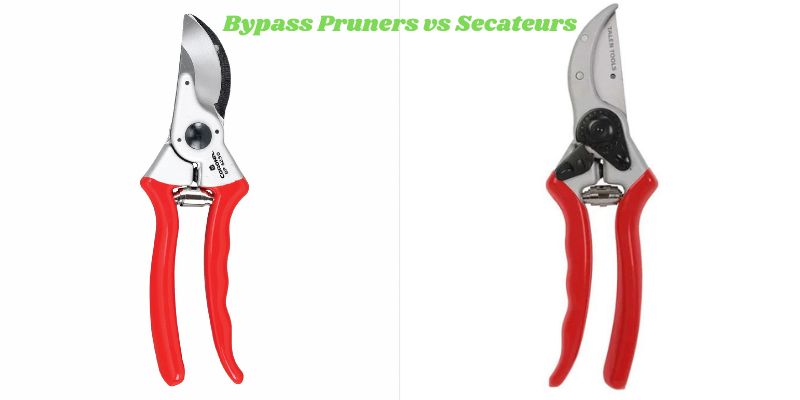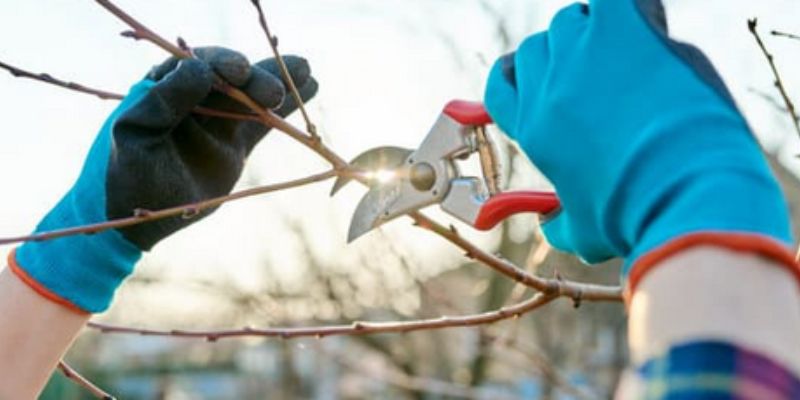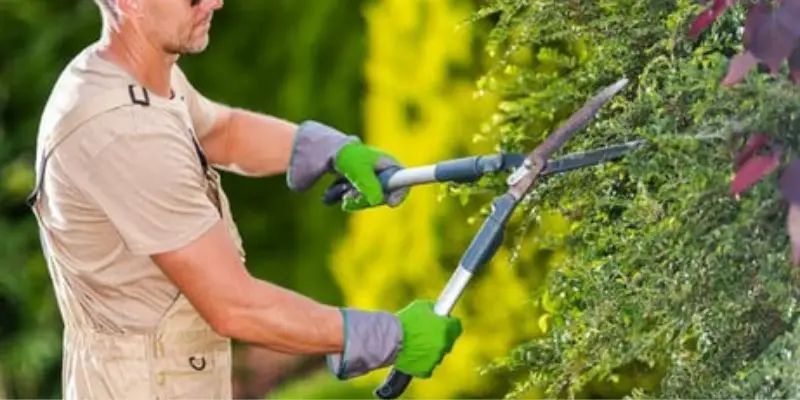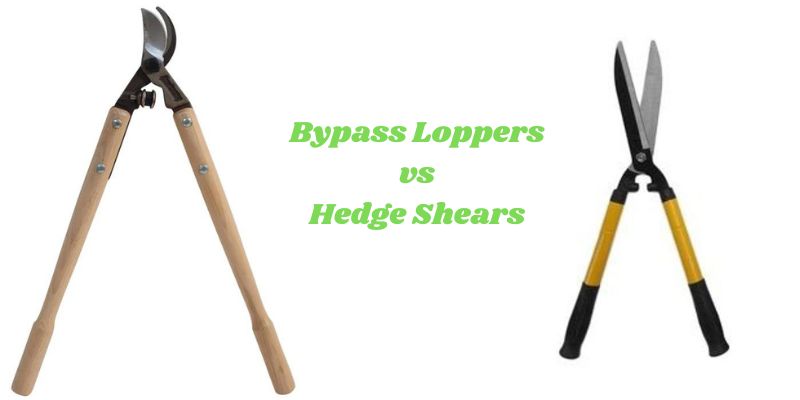As a certified arborist caring for trees and pruning various landscapes, I’m often asked about the differences between bypass pruners and secateurs (also called anvil pruners). While they may seem similar at first glance, some key distinctions between these two handheld pruning tools are important to understand. In this detailed article, I will compare bypass pruners vs secateurs based on my hands-on experience using both tools for many residential and commercial pruning jobs over the years.
By exploring their design, performance characteristics, recommended applications, and tips from real-world testing, my goal is to provide readers with objective information to help them choose the right pruning tool for their needs. Let’s start by looking at the basic designs of each tool type.
Design Differences
Bypass pruners and secateurs both function to cut woody stems and branches. However, their cutting mechanisms work in distinct ways:
- Bypass Pruners: As the name implies, bypass pruners feature cutting blades that bypass or pass each other during the cutting action. One stationary blade is located above the other pivoting blade. This bypassing motion helps prevent crushing or pinching of the plant material being cut.
- Secateurs (Anvil Pruners): Secateurs features one sharp cutting blade that moves toward a stationary anvil plate during cutting. As the blades meet, the plant material being cut is pinched between them like a pair of scissors.
This key design difference in how the blades interact during cutting impacts several factors, including:
- Cutting Ability: Bypass pruners can cut thicker branches more easily due to their bypassing motion that slices through plant material. Secateurs work best for thinner stems due to their scissors-like pinching cut.
- Effort Required: Bypass pruners require less hand pressure and effort to cut versus secateurs, which need more squeezing force applied.
- Cut Quality: The slicing cut of bypass pruners results in a cleaner cut compared to the pinched cut of secateurs, which can sometimes crush plant cells.
Beyond their cutting mechanisms, other common aspects that vary between bypass pruners and secateurs include handle design, blade sharpness/durability, and weight. Let’s explore these performance characteristics in more detail based on years of use.
Performance Characteristics
Through real-world testing and feedback from landscape clients, here are some observations I’ve made on how bypass pruners and secateurs perform in key areas:
Cutting Ability
In my years of gardening experience, I’ve found that bypass pruners truly excel when it comes to cutting thicker branches and stems. I do a lot of pruning of shrubs and smaller trees in my backyard landscape. Some of the branches can get quite woody, especially in the spring. That’s when my bypass pruners shine.
Because of their slicing motion, they cut straight through those thicker pieces of wood with very little effort. My hands don’t get nearly as tired as when I use my other pruners. If I try to cut something over 1/2 inch with my anvil pruners, it just refuses to go through. I either have to look at it a bunch of times or swap to the bypass pruners. They slice right through in one smooth cut.
Cut Quality
The quality of the cut makes a difference in how healthy and attractive the pruned areas remain. From what I’ve seen in my garden, the bypass pruners give a cleaner cut. When I use my anvil pruners, the ends sometimes look a bit jagged or crushed. Over time, I’ve noticed those crushed areas are more prone to disease or pest issues.
My bypass pruners cut so smoothly that the branch ends just look like a fresh slice every time. Less risk of problems down the road. I think it speeds up healing and growth for the plants. A clean cut is something I appreciate after doing pruning work.
Ease of Use
After pruning for many years, I’ve found bypass pruners to be much easier on my hands, especially during extended sessions. While both get tiring, there’s no question the bypass pruners require less grip strength. That scissoring motion of anvil pruners works for the hands in a pinching kind of way.
The slicing of bypass pruners feels more natural. I stay comfortable even after cutting branches for an hour or more. Anyone with hand issues would likely prefer this style too. Less fatigue means less risk of injury from overexertion. That’s an important factor as a gardener gets older like me!
Maintenance
When it comes to upkeep, I’ve noticed my bypass pruners require far less tinkering to keep running smoothly. The pivot point on my anvil pruners seems to dry out quicker and could use a drop of oil every few months. Otherwise, the blades just don’t move as freely.
My bypass pruners, on the other hand, I may oil up once per year and they’re good to go. Very low maintenance there. Both need periodic sharpening as the blades get dull. A file takes care of that pretty easily though. Overall the bypass pruners demand less TLC in my experience, which is always a plus.
Durability
For enduring regular use over multiple growing seasons, my heavier-duty bypass pruners have truly shown their robustness. My anvil pruners on the other hand haven’t held up nearly as well under the same conditions in my yard. The blades bow out of shape faster it seems.
Just minor bending early on can sap the effectiveness. Bypass pruners maintain their cutting power year after year with no such issues. They’ve proven the value of investing in a higher quality set for my needs. Reliability is so important and they deliver season after season of dependable pruning.
Weight
The one notable advantage my anvil pruners have is their lightness. After wielding the beefier bypass pruners for a while, those few extra ounces certainly start to add up on your wrists. I can appreciate that for lighter trimming jobs around flowers and vegetables.
On the flip side, their lightweight design may contribute to their shorter lifespan when putting them to work on larger shrubs. All in all, it’s a tradeoff but for my regular pruning workload, the bypass pruners get the job done weight and all. Just use them a bit at a time to avoid fatigue.
Recommended Applications
Over the years of using both bypass pruners and secateurs myself as an arborist, as well as observing other professionals at work, here are some general guidelines on their best landscape and gardening applications:
Bypass Pruners:
- Heavy pruning of branches up 1/2 inch plus in thickness
- Hedge trimming
- Shrub maintenance
- Pruning ornamental trees/shrubs with dense wood
- Landscape renovations requiring cutting of thicker stems
- Commercial applications like arborist tree services
Secateurs:
- Thinning stems and suckers under 1/4 inch
- Detailed shaping of roses and flowering shrubs
- Pruning vines, perennials
- Fruit tree maintenance
- Vineyard/orchard work
- Bonsai and detailed container pruning
- Residential yard and garden upkeep
Some additional recommended uses:
- Bypass pruners are well-suited for cutting back overgrown hedges with thicker wood. Secateurs may struggle.
- Secateurs offer more control for precise cutting in tight areas like inside rose bushes or when navigating between branches on espaliered fruit trees.
- Commercial arborists prefer bypass pruners for efficient cutting power in tree services/removals and land clearing jobs.
The applications provide a good general framework, but the individual plant material, user ability, and task often factor into the ultimate tool choice as well. Proper blade sharpness is also important for both.
Durability Testing Over Time
When recommending tools to landscape clients over the years, clients often ask about long-term durability – how long will these pruning shears or pruners last with regular use in their care? To gather a real perspective on this factor, I’ve paid attention to the condition of my pruning tools used for both residential and commercial jobs. Here are some of my observations:
- Heavier-duty bypass pruners have lasted 5 years or more with regular sharpening, while lower-end models needed replacing after 1-2 years. Fiskars is a respected durable brand.
- High-quality secateurs have performed well for 3-4 years with blade sharpening, but lower-priced ones may need replacing annually for avid gardeners. Felco is a trusted secateurs brand.
- Heavy commercial use, like cutting thick branches daily, wears out tools quicker (1-2 years) versus occasional homeowner use.
- Outdoor storage versus indoor, amount of use/day, and blade care like sharpening all influence longevity. Tools rusted faster outdoors without lubrication.
- Pivots on secateurs can get loose more readily than bypass pruners with heavy branches cutting over thick wood.
So in summary, if choosing tools for extensive frequent use in gardening/pruning, investing in quality mid-range bypass pruners and secateurs provides the best long-term value and performance versus inexpensive models that may need replacing sooner. Proper care like oiling and sharpening also helps tools last.
Ease of Use Feedback
An important factor to consider is how easy each type of pruner is for different users to operate effectively. Over the years of working with landscape clients of various ages and abilities, I’ve observed the following in terms of ease of use:
- Bypass pruners generally require less hand strength/effort to cut versus secateurs due to their slicing action. This makes them a bit easier for senior/weakened gardeners to use.
- However, some find the pinching motion of secateurs more intuitive than the scissor grip of bypass pruners, depending on hand size.
- Small-handed individuals may find shorter-handled bypass pruners and compact folding secateurs more comfortable to use than long-handled tools.
- Larger hands tend to prefer standard full-sized bypass pruners and long-handled high-leverage secateurs for efficient cutting.
- Heavier bypass pruners can tire hands more versus lightweight compact secateurs that are easy for some to hold/operate.
So in summary, user hand strength and size as well as task heavily influence which type of pruner is easier. Testing different styles can help determine the best fit. Comfort is important to prevent injury from long-term use.
Real-Life Experiences and Recommendations
Reflecting on many years of using these pruning tools both professionally and personally, here are a few additional best practices and recommendations based on real-world experience:
- Keep multiple sizes/styles of both bypass pruners and secateurs handy to suit different tasks and plant material thicknesses encountered.
- For heavy pruning jobs, pruners in each hand allow continuous cutting versus switching tools. Bypass one side, secure with secateurs.
- Use bypass pruners first to cut back overgrown material, then switch to secateurs for finer detailed shaping and trimming work.
- Periodically remove pruners from tool belt/bag and wipe dry if exposed to rain to prevent rust inside mechanism from shortened lifespan.
- Lubricate pivot points of all pruners monthly in a season with a small amount of 3-in-1 oil to keep moving parts functioning smoothly.
- Avoid leaving pruners in direct sun on hot days when possible, as plastic and wooden handles can crack or warp from excessive heat exposure over time. Provide storage in partial shade.
- Professionals may prefer replacement blades for serious commercial use versus disposable pruners. Replacement blades can be sharpened indefinitely.
- Always use proper pruning techniques suited to each plant and tool. For instance, don’t use sawing motions with pruners that could damage blades.
Overall, no single pruner is ideal for every gardening task. The key is having a quality pair of both bypass pruners and high-leverage secateurs readily available and in good condition. Rotating tools prevents hand fatigue. With a bit of practice, homeowners and professionals alike will gain confidence in choosing the right pruning tool for each job.
Preventing Injury When Using Pruners
One of the key responsibilities of today’s arborist is client and worker safety. For anyone regularly using pruners, it’s important to be aware of injury prevention best practices to protect hands from potential cuts and risks like repetitive stress. Some tips to keep in mind include:
- Always apply hand pruners close to the stem being cut to avoid excessive hand-to-blade exposure. Don’t gouge into wood.
- Keep fingers folded back behind cutting blades for safety as you squeeze the handles together.
- Wear lightweight gardening gloves for modest protection against potential nicks, especially if pruning thorny or hazardous plants.
- Take short breaks every 30 minutes if pruning for long periods to prevent overuse fatigue and risks like a carpal tunnel from improper tool use.
- Stretch and flex your hands/wrists during breaks to maintain circulation and flexibility.
- Ensure proper tool ergonomics and hand sizes are matched to the pruners used, as mentioned earlier. Avoid strain.
- Keep blades sharp via regularly scheduled sharpening to minimize hand force exerted during cutting.
- Seek prompt first aid for deeper cuts to prevent infection risks. Consider a basic first aid kit on hand.
- See a doctor promptly if overuse pain or injury symptoms like numbness or tingling develop over time. Early treatment prevents worsening issues.
With prudent safety practices programmed into one’s pruning routine, hand tools can be operated productively for many years with low risks to hands and limbs. As always, your health is the highest priority. Let safety be second nature when using garden pruners.
Frequently Asked Questions on Comparing Bypass Pruners vs Secateurs
Are bypass pruners the same as secateurs?
No, bypass pruners and secateurs differ in their cutting mechanisms. Bypass pruners slice with one moving and one stationary blade, while secateurs use a scissors-like action between two blades.
Are bypass pruners better?
Not always – each has advantages depending on the pruning situation and material thickness. Bypass pruners excel on thicker branches while secateurs can be better for finer detail work.
Why is it called a bypass pruner?
The name comes from how the moving blade bypasses past the stationary one during cutting, rather than meeting blade-to-blade like in secateurs. This allows it to slice through thicker woody stems.
What are the three types of secateurs?
The main types are anvil, by-pass, and lever action. Anvil secateurs have one sharp blade that meets a blunt plate, while lever varieties multiply cutting power.
What type of pruners are best?
It depends on the task – bypass pruners for thick branches and secateurs for finer work. Having both types enables handling different pruning needs efficiently.
What is the main difference between secateurs and shears?
While both cut plant material, secateurs are specifically made for woody stems/branches whereas shears are designed more for soft growth like spent flowers or foliage.
Conclusion
In closing, I hope this in-depth exploration has helped explain the key differences between bypass pruners vs secateurs based on my hands-on experience. While they may appear similar on the surface, their unique designs and performance characteristics make one type often better suited than the other for different pruning applications and plant materials.
Understanding factors like cutting ability, effort required, cut quality, durability, recommended uses and more will allow landscape professionals and homeowners alike to select the best pruner for their particular needs. Maintaining proper tool care like sharpening and safety is also vital to their effectiveness and longevity of use over the years.
Please feel free to contact me if you have any other questions comparing bypass pruners versus secateurs, or need recommendations on specific models based on your individual gardening and pruning requirements. I’m always happy to help provide my perspective to ensure trees, shrubs, and gardens are well-maintained and healthy for many seasons to come.

Michael has been in the landscaping world for over 15 years. After obtaining his arborist certification, he dedicated himself to sharing his immense knowledge about plants, trees, and their proper care. Pruning is Michael’s passion. He’s spent decades mastering techniques for timing, methods, and tools. Michael takes great joy in ensuring others learn to maintain beautiful, healthy gardens, and landscapes. Whether through guides, tutorials, or advice, his goal is to equip homeowners and professionals with pruning expertise.
When it comes to choosing the right equipment, Michael is also incredibly knowledgeable. He has used countless pruning tools to discover the most durable, high-quality options. Michael understands what works best in the field. His in-depth comparisons will save you time and money by finding the perfect shears, loppers, trimmers, or saws.
With great respect for horticulture and sustainability, Michael is committed to educating communities. By sharing the insights gained over a lifetime around greenery, he empowers people to steward the planet’s verdant spaces responsibly. Nature is his true passion, and Michael aims to foster others’ love of the living world through his writings.





